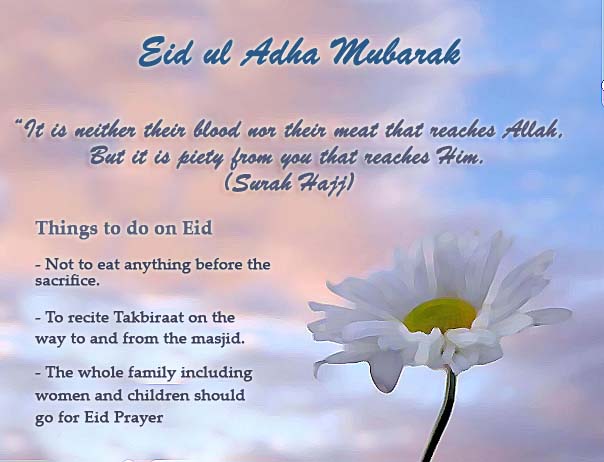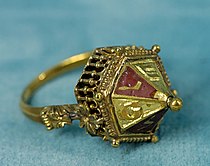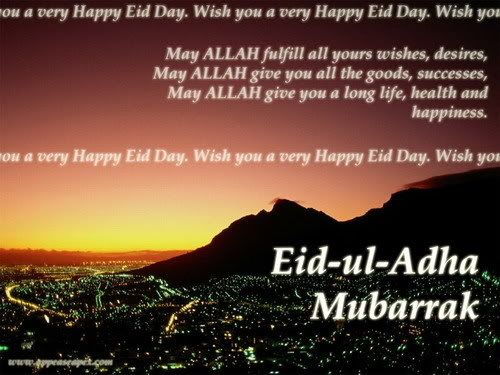
Tuesday, November 11, 2008
Traditions and practices in Eid al-Adha


Men, women, and children are expected to dress in their finest clothing to perform Eid prayer (Salatu'l-`id) in any mosque. Muslims who can afford to do so sacrifice their best domestic animals (usually sheep, but also camels, cows, and goats) as a symbol of Ibrahim's (Abraham's) sacrifice. The sacrificed animals, called "udhiya" Arabic: أضحية" also known as "qurbani", have to meet certain age and quality standards or else the animal is considered an unacceptable sacrifice. Generally, these must be at least a year old. At the time of sacrifice, Allah's name is recited along with the offering statement and a supplication as Muhammad said. According to the Quran, the meat is divided into three shares, one share for the poor, one share for the relatives and neighbors, and the last to keep to oneself. A large portion of the meat MUST be given towards the poor and hungry people so they can all join in the feast which is held on Eid-ul-Adha. The remainder is cooked for the family celebration meal in which relatives and friends are invited to share. The regular charitable practices of the Muslim community are demonstrated during Eid ul-Adha by the concerted effort to see that no impoverished Muslim is left without sacrificial food during these days. Eid ul-Adha is a concrete affirmation of what the Muslim community ethic means in practice. People in these days are expected to visit their relations, starting with their parents, then their families and friends. (Arabic audio with English meaning).
Eid al-Adha

Eid-ul-Adha (Adha Eid) has other popular names across the Muslim world, such as Eid el-Kibiinitiopr (the 'Big' Eid) in Morocco, Algeria, Syria, Tunisia, Egypt, Yemen and Libya; Tfaska Tamoqqart in the Berber language of Jerba; Tabaski or Tobaski in West Africa; Babbar Sallah in Nigeria; Ciidwayneey in Somalia and Somali-speaking regions of Kenya and Ethiopia.
In India and Pakistan it is also called Bari Eid (literally "Big Eid"). In Kashmir, where Kashmiri is spoken, it is called Baed Eid, and Keralites who speak Malayalam say Waliya Perunnal, both phrases also meaning "Big Eid." In Bangladesh it is called either ঈদ-উল-আজহা Id-ul-Azha or কোরবানী ঈদ Korbani Id. In South Africa it is also called Bakra Eid (or simply Baqrid in India, for the Hindi word baqara, meaning "goat", the traditional sacrifice).
In Southern Indian state of Tamil Nadu, and in Sri Lanka, which has large concentration of Tamil-speaking Muslims, it is called Peru Naal meaning 'The Big Day'. Sometimes, Tamil-speakers say Bakr Eid Peru Naal, meaning 'the Big Day of the Sacrifice'.
In Turkey it is called Kurban Bayramı. Similarly, in Bosnia and Herzegovina, Albania, Kosovo and Bulgaria it is referred as Kurban Bajram, the same root with Qorban Bäyräme in Tatarstan, Qurban Bayramı in Azerbaijan and Kurban Bayram throughout Russia. In Kazakhstan, it is referred to as Qurban Ait. In Iran and Afghanistan it is called "Eyd e Qorbán" by Persian-speakers and Loy Akhtar (literally, "the Greater Eid") or Kurbaneyy Akhtar by Pashto-speakers.
By the Kurds it is called Jejhni Qurban meaning Feast of Sacrifice.
In China it is called "Corban Festival" (古尔邦节、宰牲节 in Chinese) or "Qurban Heyit" in Uyghur language.
In the Malay Archipelago, especially in the Malay-speaking areas; Malaysia, Singapore, Indonesia and Brunei, the term "Idul Adha" (particularly in Indonesia) or "Aidil Adha" is used. "Hari Raya Korban", which means the Sacrifice Celebration Day is also widely used. Another term is called "Hari Raya Haji" which means Celebration Day of the Hajj.
In India and Pakistan it is also called Bari Eid (literally "Big Eid"). In Kashmir, where Kashmiri is spoken, it is called Baed Eid, and Keralites who speak Malayalam say Waliya Perunnal, both phrases also meaning "Big Eid." In Bangladesh it is called either ঈদ-উল-আজহা Id-ul-Azha or কোরবানী ঈদ Korbani Id. In South Africa it is also called Bakra Eid (or simply Baqrid in India, for the Hindi word baqara, meaning "goat", the traditional sacrifice).
In Southern Indian state of Tamil Nadu, and in Sri Lanka, which has large concentration of Tamil-speaking Muslims, it is called Peru Naal meaning 'The Big Day'. Sometimes, Tamil-speakers say Bakr Eid Peru Naal, meaning 'the Big Day of the Sacrifice'.
In Turkey it is called Kurban Bayramı. Similarly, in Bosnia and Herzegovina, Albania, Kosovo and Bulgaria it is referred as Kurban Bajram, the same root with Qorban Bäyräme in Tatarstan, Qurban Bayramı in Azerbaijan and Kurban Bayram throughout Russia. In Kazakhstan, it is referred to as Qurban Ait. In Iran and Afghanistan it is called "Eyd e Qorbán" by Persian-speakers and Loy Akhtar (literally, "the Greater Eid") or Kurbaneyy Akhtar by Pashto-speakers.
By the Kurds it is called Jejhni Qurban meaning Feast of Sacrifice.
In China it is called "Corban Festival" (古尔邦节、宰牲节 in Chinese) or "Qurban Heyit" in Uyghur language.
In the Malay Archipelago, especially in the Malay-speaking areas; Malaysia, Singapore, Indonesia and Brunei, the term "Idul Adha" (particularly in Indonesia) or "Aidil Adha" is used. "Hari Raya Korban", which means the Sacrifice Celebration Day is also widely used. Another term is called "Hari Raya Haji" which means Celebration Day of the Hajj.
Style, Fashion of a Ring

A plain gold band is the most popular pattern. Medical personnel commonly wear it because it can be kept very clean. Women usually wear narrow bands, while men wear broader bands.
In France and French-speaking countries, a common pattern consists of three interwoven rings. They stand for the Christian virtues of "faith, hope and love", where "love" equates to that particular type of perfect disinterested love indicated by the ancient Greek word agape. Provocatively, this pattern slides off quickly, because the rings flow over each other.
Women in Greek and Anatolian (comprising most of modern Turkey) cultures sometimes receive and wear puzzle rings – sets of interlocking metal bands that one must arrange just so in order to form a single ring. Traditionally, men wryly gave them as a test of their woman's monogamy. However, with time and practice it takes little effort to re-make the puzzle and any intelligent woman can learn.
In North America and some European countries, many married women wear two rings on the same finger: an engagement ring and a plain wedding band. Couples often purchase such rings as a pair of bands designed to fit together. In addition, some women who have been married a long time wear three rings on their finger (from hand to tip): a wedding band, an engagement ring, and an eternity ring. This three-ring combination is especially common in the UK.
Engraving wedding bands is also becoming very popular in the United States.
Celtic-style wedding bands have become more popular in the U.S., Canada and other English-speaking countries with large numbers of people claiming Irish or Scottish descent. This style of wedding band will often be engraved or embossed with a Celtic knot design, which is meant to symbolize oneness and continuity. Sometimes a Claddagh design is also used to symbolize fidelity.
In France and French-speaking countries, a common pattern consists of three interwoven rings. They stand for the Christian virtues of "faith, hope and love", where "love" equates to that particular type of perfect disinterested love indicated by the ancient Greek word agape. Provocatively, this pattern slides off quickly, because the rings flow over each other.
Women in Greek and Anatolian (comprising most of modern Turkey) cultures sometimes receive and wear puzzle rings – sets of interlocking metal bands that one must arrange just so in order to form a single ring. Traditionally, men wryly gave them as a test of their woman's monogamy. However, with time and practice it takes little effort to re-make the puzzle and any intelligent woman can learn.
In North America and some European countries, many married women wear two rings on the same finger: an engagement ring and a plain wedding band. Couples often purchase such rings as a pair of bands designed to fit together. In addition, some women who have been married a long time wear three rings on their finger (from hand to tip): a wedding band, an engagement ring, and an eternity ring. This three-ring combination is especially common in the UK.
Engraving wedding bands is also becoming very popular in the United States.
Celtic-style wedding bands have become more popular in the U.S., Canada and other English-speaking countries with large numbers of people claiming Irish or Scottish descent. This style of wedding band will often be engraved or embossed with a Celtic knot design, which is meant to symbolize oneness and continuity. Sometimes a Claddagh design is also used to symbolize fidelity.
Subscribe to:
Comments (Atom)


